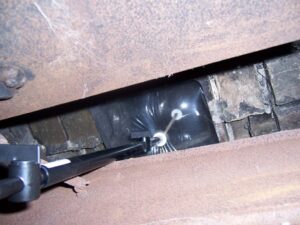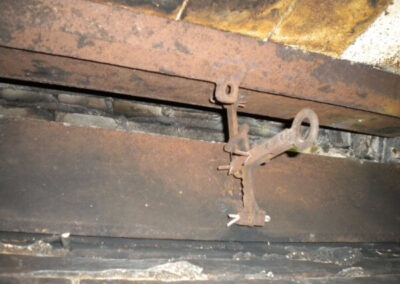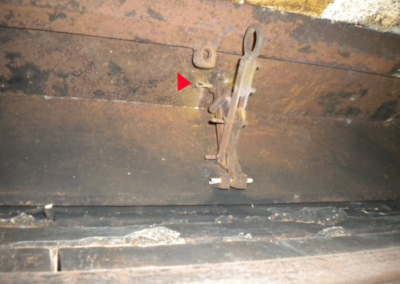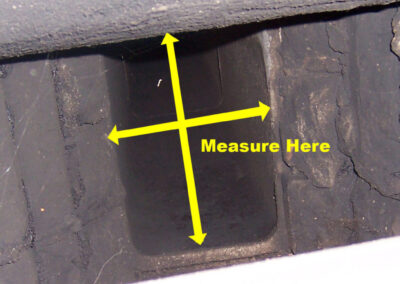Fireplace #25: Multi-Hinge Damper
These Multi Hinge Dampers are not very common. They are sturdy, but also really over-engineered and not easy to disassemble. Here are the characteristics of this damper:
- You swing the center damper handle that hangs down into the firebox from front to back to open and close the damper door.
- There are numerous cotter pins operating hinges that actuate the damper.
- There is a long rectangular damper frame and matching damper door.
- Multi- Hinge dampers actuate almost identically to Vestal Dampers, except they have a more complicated actuator.
Because of the hardware below the damper, there are two ways to plug this flue.
If you want to plug it and forget it, use the Flueblocker
If you don’t use your fireplace very much and you just want a way to plug the flue for a long duration, go with a Flueblocker. Here is a video on how the Flueblocker works. Remove the cotter pin that holds the damper door to the damper handle (image 25-2 see red arrow). Measure the length and width of the damper door, and buy a Flueblocker that is slightly larger that that size. You will likely need a 8×32 or 9×45 Flueblocker.
You will need to thread the wool pad of the Flueblocker between the detached damper handle, and the damper door. It is a tight fit, but the wool pad will effectively cover the closed damper door.
What about the Chimney Balloon?
 If you are lucky enough to have a low flue tile like this photo, you can use a Chimney Balloon to plug the flue tile. You would need to get a measurement of the length and width of the flue tile first (image 25-3), so you will know what size Chimney Balloon to use. Flue tiles generally take a 12×12, 15×15 or 24×12. Also purchase a HEK handle extender to give the handle some extra length to reach the flue tile. The Chimney Balloon will require a top-off of air each 6 to 12 months, and it is not quite as durable as the other two options above. So consider it a “Plan B” for this application.
If you are lucky enough to have a low flue tile like this photo, you can use a Chimney Balloon to plug the flue tile. You would need to get a measurement of the length and width of the flue tile first (image 25-3), so you will know what size Chimney Balloon to use. Flue tiles generally take a 12×12, 15×15 or 24×12. Also purchase a HEK handle extender to give the handle some extra length to reach the flue tile. The Chimney Balloon will require a top-off of air each 6 to 12 months, and it is not quite as durable as the other two options above. So consider it a “Plan B” for this application.


